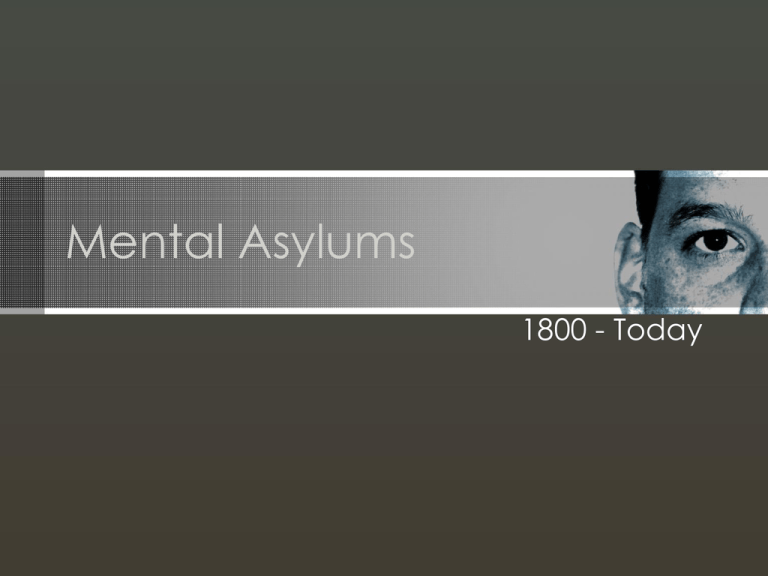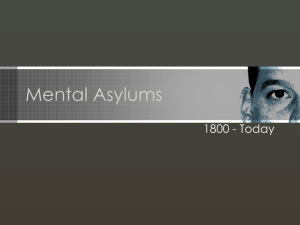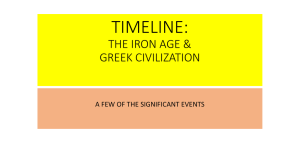Asylum PPT
advertisement

Mental Asylums 1800 - Today The first mental asylums were th built in the 8 century • Buildings housed the mentally ill with little to no treatment • Major European cities began establishing actual asylums between 1200 and 1800 • With the passing of the 1828 Madhouse Act, England granted money to build asylums within major cities to house the mentally ill Unfortunately … • Early asylums simply placed the ill into a prison or group home setting. Nothing was done to improve their state of being • During the 18th century, certain mental hospitals in England would charge a penny to allow outsiders to come in and witness the “crazies.” • In 1700, the word patient was finally used with the mentally ill – before that they were only referred to as lunatics. • In 1720, mental hospitals finally began to separate patients by illness • Around this time, mental illness became accepted as a disease Mental Asylums in the United States • Unlike other regions of the world, U.S. asylums tended to focus on treatment instead of punishment. • Treatments, however, varied from promising to disturbing The Patients • Those admitted ranged from the mentally insane to those with what we would consider mild disorders today. • New mothers, misunderstood teenagers, the depressed, the elderly, the addicted and felons were often put into asylums because families were embarrassed by them or didn’t know what to do with them Government Asylums • Many U.S. asylums were funded by taxpayers. • Tri-State or regional hospitals were located in rural settings. • This allowed plenty of land at a cheap price which protected the patients and the people living around the hospital. Ohio Asylums Longview State Hospital (Cincinnati – 1838) The Lunatic Asylum of Ohio (Columbus – 1838) Cleveland State Hospital 1855 Dayton State Hospital 1855 Athens State Hospital 1874 Toledo State Hospital 1888 Massillon State Hospital 1898 Lima State Hospital 1915 U.S. Hospital Design • Many state hospitals in the United States were built on the Kirkbride Plan (an architectural style meant to help cure the patients) The Kirkbride Plan • Focused on using light and space as a healing device. • Wings and wards were created with wide hallways, large windows, and spacious main rooms. The Athens Insane Asylum The Athens Mental Asylum • Then The Athens Mental Asylum • Now The Athens Asylum for the Insane • The Athens Mental Health Center opened on January 9, 1874 on 1,000 acres purchased from the Coate’s farm. • With the Civil War ending, asylums were needed to house vets suffering from post traumatic stress disorder. The Grounds • The grounds of the Athens Insane Asylum were designed by the same person who designed Central Park. • The people of Athens often spent their weekends in the parks and ponds surrounding the hospital, intermingling with the patients. Athens Mental Asylum • 544 patient rooms • It opened with 200 patients • Calmer patients participated in recreational activities like boating, painting, dances, and picnics • They were offered church services and plays, and were free to roam the grounds The Children’s Ward • This building housed both ill children and healthy children who had ill parents • A tunnel connected this building to the main buildings. This was so that mothers could visit their children • The main building had a viewing porch where parents could watch as their children played outside The Evolution of a Name • As times changed, so did Athens Mental Hospital’s name • Athens Hospital for the Insane • Athens Asylum for the Insane • Athens State Hospital • Southeastern Ohio Mental Health Center • Athens Mental Health Center • Athens Mental Heath and Mental Retardation Center • Athens Mental Health and Development Center • Athens Mental Heath Center (again) The Hospital’s Growth • The population of the Athens Asylum shot up from 200 when it opened to nearly 2,000 in the early 1900’s • Overcrowding led to the sharing of patient rooms and a severe decline in the quality of treatment administered by a staff which had barely increased in size since 1874 Athens Insane Asylum 1908 The Treatments Water Treatment • Patients were submerged in icecold water for extended periods of time • Sometimes they were wrapped in or restrained in sheets which had been soaked in ice water Aggressive Water Treatment • Cold wet packs – Patients were wrapped in ice cold, wet sheets – Used to control movements and restrain people • Hydrobaths – Patients were restrained in warm baths and covered with canvas – Used on patients who suffered from seizures Shock Therapy • Electric shocks were administered to patients submerged in water tanks or, more commonly, directly to the temples by the application of brine soaked electrodes. • A patient held a rubber piece in his mouth to prevent him from biting his tongue off during the convulsions which followed a treatment Lobotomy (Original) • Patients had their skulls opened and their neural passages separated midway through the brain. • This procedure killed many people. • Those who survived forgot many of their depressive or psychotic tendencies. • They also forgot a lot of other things. Lobotomy (Trans-Orbital) • Developed by Dr. Walter J. Freeman in the early 1950’s. • The Lobotomist Housing of Patients • Overcrowding was the norm • Patients were stacked in bunks and even locked in cages to ensure security • Some violent patients were placed in bare rooms with no furniture or even a toilet. Their clothes were taken and they were forced to remain in the room for hours at a time Patients often left messages due to their mental state Mental Health Treatment Today • Testing and observation • Group and individual counseling • Therapy • Recreational therapy • Modern, FDA approved medication • Families also receive counseling and are involved in the process The Downfall Closing the state hospitals • During the 1980’s Ronald Reagan cut funding for state mental hospitals. • Mental hospitals were given very little notice that they would be closing. • Only a few patients were moved to other hospitals or prisons • Most patients were released into the surrounding towns with only the clothes they were wearing Closing the state hospitals • Many of the buildings were shut down on only a few days notice • The Children’s Ward at Athens was shut down very quickly resulting in many kids being separated from their parents • Prior to renovations in 2000, the rooms were still decorated for Christmas, as it was shut down during the holiday season. The Cemeteries The Cemeteries • Most of the people who died while in mental asylums were buried at the asylum’s cemetery. • Gravestones were numbered and often records were misplaced . The Cemeteries • At Athens, OU buried medical cadavers in the same cemeteries used for people who died in the insane asylum. The Athens Insane Asylum Today Today … • Buildings consist of classrooms, art museum, storage, and offices • OU discussed putting dorms within the buildings, but that didn’t go over well • Many of the previous patients who were not transferred were released into the city and still live in the area The Stain Look closely … The Stain • On December 1, 1978, patient Margaret Schilling disappeared from one of the active wards. • On January 12, 1979, they found her body in the abandoned top floor of ward N. 20 • This ward had been used for sick, infectious patients, and had been closed down for years. The Stain • They had searched the hospital for the woman when they realized she was missing, but apparently hadn’t looked in ward N. 20. • When a maintenance man discovered her body lying on the floor in front of a window, she had been dead for several weeks. The Stain • The official cause of death was heart failure – probably due to her exposure to the December cold in an unheated section of the hospital • She apparently locked herself in the ward as a game, hiding from hospital employees The Stain • Before she died she took off her clothes and folded them neatly nearby • Over the weeks she was there, a negative was formed on the concrete due to a reaction with the decomposing body, sunlight and concrete. www.forgottenoh.com Contains haunted places in Ohio and other crazy stuff! First Hand Accounts Susanna Kaysen, Girl Interrupted Her Suicide Attempt…. • “Suicide is a form of murder– premeditated murder.” • “It’s important to cultivate detachment.” • “The motive is paramount. Without a strong motive, you’re sunk.” • “My motives were weak: an American- history paper that I didn’t want to write.” • “Actually it was only part of me that I wanted to kill: the part that wanted to kill herself…” • “I didn’t figure this out, though, until after I’d swallowed the fifty aspirin. Others within the Asylum… • “One girl among us had set herself on fire. She used gasoline.” • “I think the gasoline had settled in her collarbone, forming pools there beside her shoulders, because her neck and cheeks were scarred the most.” • Why did she do it? Nobody knew. Nobody dared to ask. Because- what courage! Who had the courage to burn herself? Twenty aspirin, a little slit alongside the veins of the arm, maybe even a bad half hour standing on a roof: We’ve all had those.” Being Controlled… • “Five minute checks. Fifteen-minute checks. Half-hour checks. Some nurses said, “Checks,” when they opened the door. Click, turn the knob, swish, open the door, “Checks,” swish, pull the door shut, click, turn the knob. Five-minute checks. Not enough time to drink a cup of coffee, read three pages of a book, take a shower.” • “It never stopped, even at night, it was our lullaby. It was our metronome, our pulse.” The smallest things… • “Nail scissors. Nail File. Safety razor. Penknife. Pin. Georgina’s gold stud earrings. That belt. Knives. Well, you could make a case for knives. But forks and spoons too?” • “We ate with plastic. It was a perpetual picnic, our hospital.” • “One month the plastic-utensil delivery was late and we ate with cardboard knives and forks and spoons… Imagine the taste of it, melting clotted cardboard in and out of your mouth, rubbing on your tongue.” Ward 81 Asylum stories by photo. Ward 81








